Climate change alters the planet, threatening nature, people, and your favorite vacation spots. Tourism isn’t just a victim of climate change—it also contributes nearly 9% of global emissions. Carbon offsets provide a way to counteract this impact by funding projects that reduce or remove emissions elsewhere.
By offsetting the unavoidable emissions from flights and other travel activities, you can support climate solutions that protect nature and local communities. Keep reading to discover how carbon offset programs work, explore different project types, and learn how to purchase high-quality carbon credits to balance your travel carbon footprint.
Key Takeaways
|
Understanding Carbon Offsets
What Are Carbon Offsets
Carbon offsets are a way to compensate for emissions from your travel, daily life, or business by funding projects that reduce or remove greenhouse gases elsewhere. These projects can take many forms, from renewable energy initiatives to reforestation efforts.

Flights are the most significant source of travel emissions, but boat trips, driving, and hotel stays also contribute to tourism’s carbon footprint. Travelers and businesses can reduce their emissions through climate-friendly practices. However, since you cannot eliminate all emissions immediately, carbon offsets provide a practical way to take responsibility for your impact while supporting climate solutions worldwide.
Free Climate-Friendly Travel Tips List
Carbon Offsets vs Carbon Credits
To offset carbon, individuals and businesses purchase carbon credits. A carbon credit is a commodity that can be bought and sold, with each credit representing one metric ton of CO₂ avoided or removed. These credits are issued by projects that generate emission reductions, and purchasing them helps fund and sustain those efforts.

The terms “carbon offsets” and “carbon credits” are often used interchangeably, but there is a slight distinction between them. Carbon offsetting refers to the action of compensating for emissions, while carbon credits are what you purchase to achieve that goal. However, buying a carbon credit isn’t enough to offset your emissions. You also have to retire the credit, removing it from the market, so no one else can use it.
For example, if your flight emits two metric tons of CO₂, you must buy and retire two carbon credits to offset it.
Voluntary vs Compliance Carbon Markets
The carbon market is the system where carbon credits are bought and sold. It operates in two forms: the compliance carbon market and the voluntary carbon market. The main difference is that legal requirements drive compliance markets, while voluntary markets are driven by choice.
In the compliance market, governments set emissions caps, requiring high-emission industries, such as energy, aviation, and manufacturing, to reduce their emissions or purchase carbon credits to stay within their limits. Programs like the EU Emissions Trading System and California’s Cap-and-Trade Program are examples.
The voluntary market, by contrast, comprises businesses and individuals who offset emissions without any legal obligation, typically motivated by sustainability goals, brand values, or customer expectations.
How Carbon Offsetting Works
While it may initially sound complex, carbon offsetting is a straightforward concept. Here’s how it works:
1. Calculate Your Carbon Footprint
To offset emissions, individuals or businesses first need to estimate how much carbon they produce using a carbon calculator. Our travel carbon footprint calculator measures emissions from commercial flights, hotels, car rentals, road trips, cruises, yachting, private jets, and dive liveaboards. Businesses can use specialized tools like our tour and event footprinting tools, API integration, or corporate carbon assessment. For example, a round-trip economy class flight from New York to London produces around 1.5 metric tons of carbon emissions.

2. Buy Carbon Offsets From a Reputable Provider
Once you’ve calculated your emissions, the next step is to purchase carbon offsets from a reputable provider. Below, we’ve outlined further guidance on sourcing high-quality credits.
3. Your Carbon Offset Purchase Funds Projects that Fight Climate Change
Your offset dollars support projects that fight climate change by removing existing carbon dioxide from the atmosphere or preventing new emissions from being released. These carbon offset projects tackle different emissions sources using various approaches.

Types of Carbon Offset Projects
Carbon offset projects come in many forms, but they all have the same goal: to reduce or remove greenhouse gas emissions that drive climate change.
Avoidance vs Removal Projects
Carbon offset projects fall into two main categories: avoidance and removal. Avoidance projects prevent future emissions from occurring—for example, building a wind farm to replace fossil fuel energy or protecting forests from being cleared. On the other hand, removal projects draw down carbon already in the atmosphere through methods like reforestation or direct air capture.
The following sections highlight common types of carbon offset projects that achieve either avoidance, removal, or a combination of both. Want to see how different carbon offset projects compare at a glance? Explore our Carbon Offset Project Comparison Guide for a side-by-side look at project types, climate strategies, and key differences.
Forest Carbon Offset Projects
Forests help fight climate change by absorbing and storing carbon through photosynthesis. Forest-based carbon offset projects tap into this power by protecting, restoring, or improving the management of forests to maximize their climate benefits.
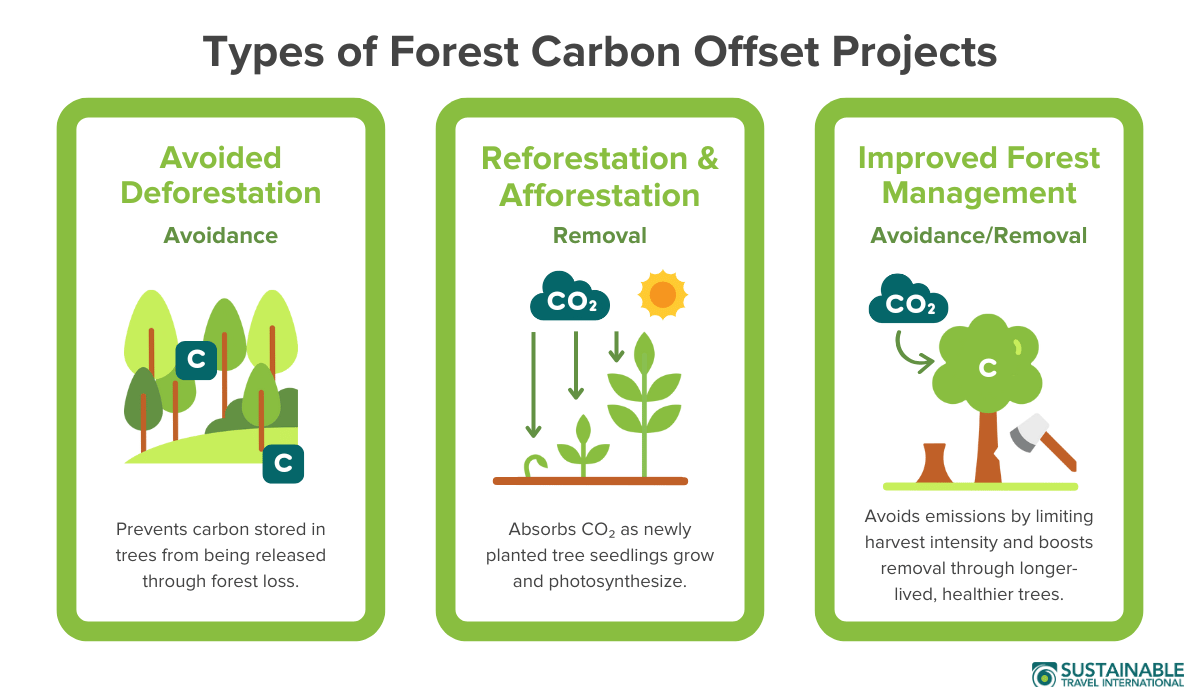
There are three main types of forest carbon offset projects:
- Avoided deforestation projects prevent forest loss from threats like logging, mining, or agricultural expansion, protecting trees and ecosystems that would otherwise be at risk. For example, the Yaeda-Eyasi project protects the ancestral lands of Indigenous communities in Tanzania from being converted into cropland by encroachers.
- Reforestation restores tree cover in areas affected by deforestation or natural disturbances, while afforestation creates new forests on land that has never been forested or hasn’t had tree cover in decades. For example, the Green Trees project is restoring one million acres of farmland into hardwood forest in the Lower Mississippi Valley.
- Improved forest management projects enhance carbon storage by adopting practices like extending harvest cycles, allowing trees to grow larger and absorb more carbon. For example, the Blandin Native American Hardwoods project enhances carbon sequestration in Minnesota’s pulp and sawlog forests using practices that emulate natural ecological patterns and maintain tree diversity.
To put it in perspective, offsetting the emissions from that round-trip flight between New York and London would require growing 25 tree seedlings for 10 years—or protecting 1.5 acres (0.9 hectares) of forests from deforestation for one year.
Energy Carbon Offset Projects
Energy carbon offset projects reduce greenhouse gas emissions by changing how energy is produced, used, and sourced. These projects replace fossil fuel-based power with clean, renewable energy, recover energy from organic waste, and reduce demand through more efficient appliances and systems.
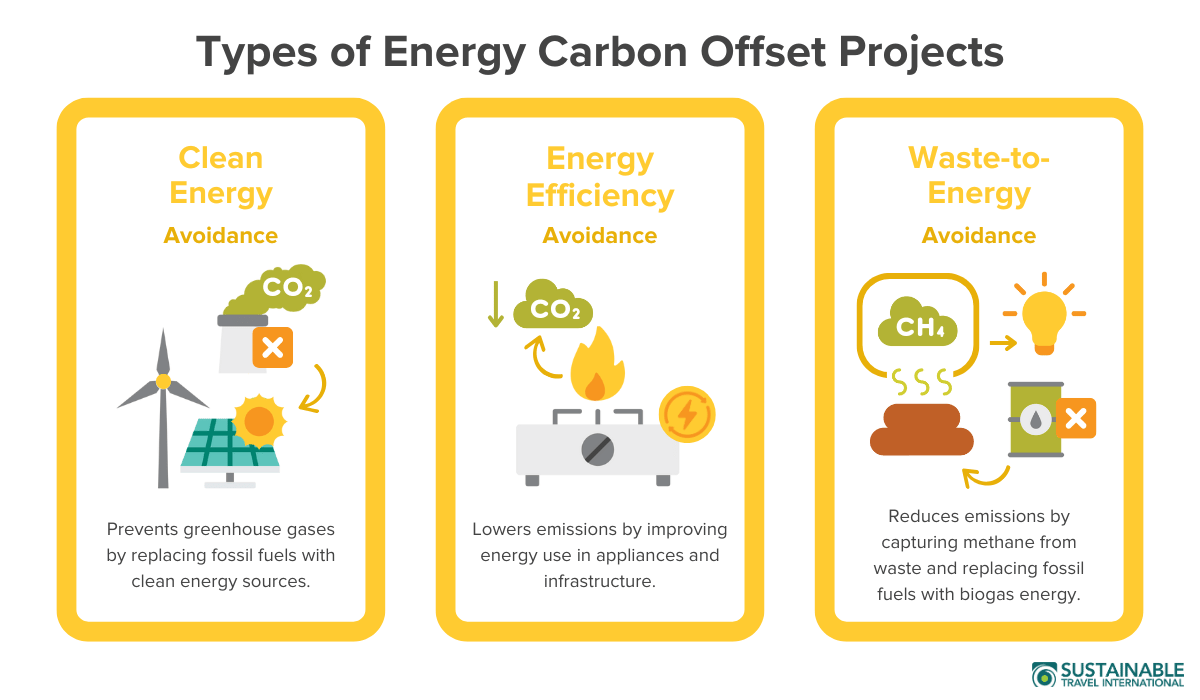
The following are the main types of energy carbon offset projects:
- Clean energy projects reduce emissions by replacing fossil fuel-based power with clean, renewable sources like wind, solar, or hydro. Unlike fossil fuel plants, renewable energy avoids carbon and pollutant emissions. For example, the Larimar Wind Farm in the Dominican Republic harnesses sea breezes to supply clean electricity to the grid, reducing dependence on imported fossil fuels.
- Waste-to-energy projects reduce emissions by converting non-recyclable waste into usable energy through various technologies. These projects transform waste into energy carriers, like gaseous or liquid fuels, which can generate electricity or heat, displacing fossil or biomass fuels. For example, the Vietnam Biogas project installs digesters that convert animal manure into biogas, which families use for cooking and lighting. Another example is the Santa Marta Landfill Gas project, which captures methane from a landfill in Santiago, Chile, and converts it into electricity.
- Energy efficiency projects reduce the energy needed for a task, lowering the use of biomass and fossil fuels. These projects can range from community-level initiatives targeting household appliances to industry-level improvements in buildings and transportation. For example, the Garo Clean Cookstoves project in India replaces traditional stoves with more efficient models that use less firewood, cutting emissions and easing pressure on nearby forests.
To offset the emissions from that same round-trip flight from New York to London would require avoiding burning 1,666 pounds (756 kilograms) of coal or 147 gallons (556 liters) of diesel.
Waste Disposal and Industrial Processes Carbon Offset Projects
Beyond waste-to-energy initiatives, other carbon offset projects focus on managing waste and industrial byproducts to reduce greenhouse gas emissions.
Waste disposal projects include capturing and destroying methane released from rotting organic material, recycling to avoid emissions from producing new materials, and composting to stop methane from forming in the first place. For example, the Quanzhou Canhua PET Recycling Project in China turns used plastic drink bottles into new plastic flakes, cutting carbon emissions by avoiding the need to make new plastic from oil and gas.
Offsetting emissions from that same round-trip flight from New York to London would require recycling 128 bags of trash instead of landfilling.
Industrial processes carbon offset projects tackle pollution from manufacturing and chemical processes by destroying or replacing potent greenhouse gases. These projects might capture methane leaking from coal mines, destroy nitrous oxide produced during chemical manufacturing, or replace high-emission refrigerants with cleaner alternatives.
Blue and Teal Carbon Offset Projects
Blue carbon offset projects protect and restore coastal ecosystems like mangroves, while teal carbon projects focus on freshwater wetlands. Though they cover less area than forests, these ecosystems can absorb carbon up to 10 times faster. They can also store twice as much carbon per equivalent area—primarily in soils, where slow decomposition traps it for thousands of years.
An example of a blue carbon project is Mikoko Pamoja, a community-based initiative conserving and restoring mangroves along Kenya’s southern coast. A teal carbon example is Rimba Raya, which protects Indonesia’s peat swamp forests—a critical habitat for rehabilitated orangutans, once slated for conversion to palm oil plantations.
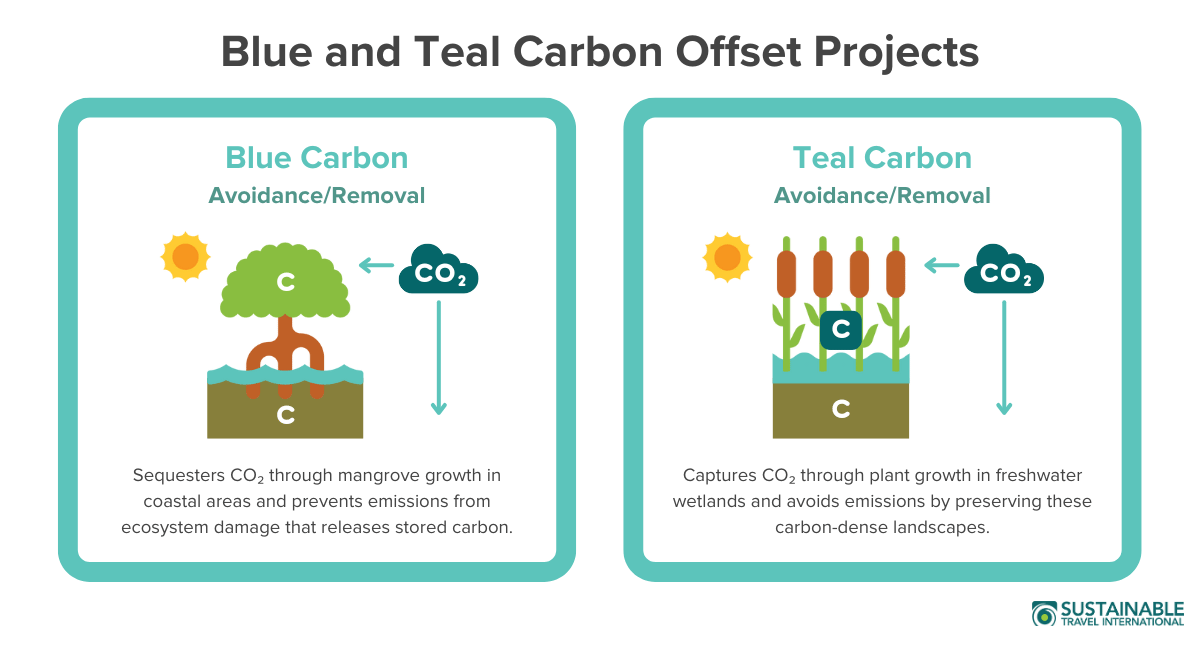
Agriculture
Agricultural carbon offset projects reduce emissions through land and livestock management strategies that target high-emission practices and increase carbon storage in soil and vegetation.
- Sustainable crop practices reduce greenhouse gas emissions by lowering the use of synthetic fertilizers and other high-emission inputs and improving crop management techniques that minimize nitrous oxide emissions.
- Agroforestry projects remove carbon from the atmosphere by incorporating trees into agricultural systems, which store carbon in their biomass over time.
- Livestock and grazing practices reduce methane and nitrous oxide emissions through improved feeding strategies, manure management systems like biodigesters, and grazing approaches that enhance carbon uptake in grassland soils and reduce land degradation.
- Soil carbon sequestration projects increase the carbon held underground by improving how plants interact with soil microbes or adopting regenerative land management practices.
Technological Carbon Removal
Technological carbon removal uses engineered solutions to capture and store carbon in long-lasting forms. For example, direct air capture (DAC) uses machines and chemical processes to pull carbon dioxide directly from the air. The captured CO₂ is stored underground for permanent removal or used in products like fuels and concrete.
In addition to purely engineered solutions, technology can also enhance natural carbon removal processes. These approaches accelerate or strengthen nature’s ability to sequester carbon:
- Biochar projects stabilize carbon from organic materials by converting them into a solid charcoal-like substance using high heat and low oxygen. This stable carbon is then added to the soil, where it can remain locked away for hundreds of years. In Thailand, the WongPhai Bamboo Biochar project turns bamboo waste into biochar and applies it to fields to store carbon permanently.
- Enhanced weathering projects remove carbon dioxide from the air by spreading crushed rocks like basalt over land, where they chemically react with CO₂ and water to form stable minerals that store carbon permanently.
- Some soil carbon sequestration projects may utilize biological additives or treatments that accelerate carbon storage. For example, the Rootella project in the U.S. Corn Belt applies mycorrhizal fungi to crops at planting, boosting the plants’ ability to absorb carbon and store it in the soil.
How Many Carbon Credits Have Been Offset By Project Type?
Now that you’ve explored the range of carbon offset project types, it’s helpful to understand how each contributes to global carbon offsetting efforts.
The chart below shows the number of carbon credits that have been retired each year by project type, reflecting which activities account for the majority of offsets. This breakdown highlights the impact of different solutions, the growth of the carbon market, and trends in how the world is choosing to offset emissions. While avoided deforestation and renewable energy projects have dominated the market for years, other categories like blue carbon and innovative tech are beginning to grow more prevalent. Together, these approaches provide a toolkit for removing carbon at scale and addressing emissions that are difficult or impossible to eliminate.

The Role of Carbon Offsets in Achieving Net-Zero
According to the Glasgow Declaration for Climate Action in Tourism, to avoid the worst impacts of climate change, global tourism emissions must decline by 50% by 2030 and reach net zero by 2050. The top priority is reducing emissions across a business’s operations and value chain. However, this takes time and often depends on broader systemic shifts, like decarbonizing electric grids, improving food systems, and transforming transportation infrastructure. Even businesses with firm climate commitments may be constrained by limited access to low-carbon technologies or the financial burden of implementing them at scale.
That’s where high‑integrity carbon credits come in: they’re no excuse to dodge the hard work of cutting one’s own emissions, but a complementary lever that lets individuals and businesses bankroll projects that deliver measurable climate benefits today while catalysing the deeper, system‑wide transformations needed for lasting decarbonisation.
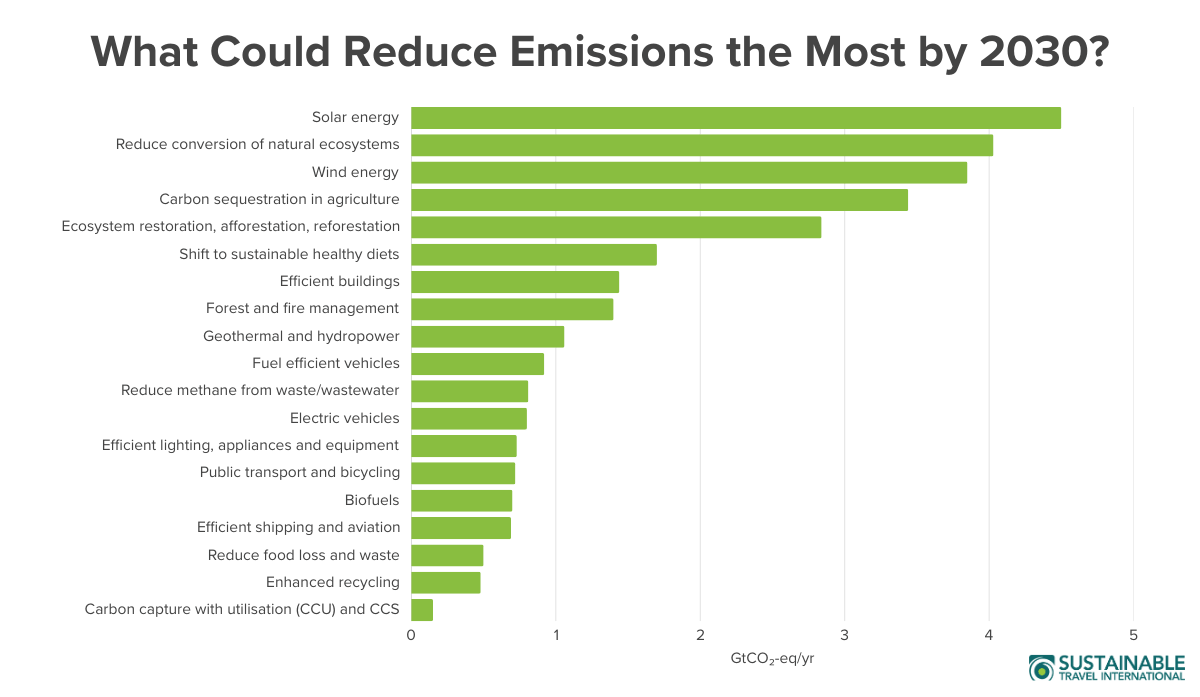
As the United Nations explains, “Offsetting plays an important catalytic role for rapidly deploying solutions where it is economically most viable.” Offsets offer an accessible way for any business or traveler to take action now about their unavoidable emissions. They also shift the financial burden of low-carbon development away from countries least responsible for the climate crisis and onto those that helped cause it, while protecting developing countries’ right to grow.
For example, preventing deforestation through carbon offset projects in countries like Brazil can deliver the same emissions reductions for just 1/50th the cost of sustainable aviation fuel. That doesn’t mean we should stop investing in SAF or other decarbonization efforts—far from it. However, offsets allow us to reduce carbon faster while those technologies continue to scale.
That means putting dollars into high-quality avoidance credits that prevent emissions now and help fund the transition in the near term. In fact, 91% of the carbon credits retired in 2024 came from avoidance projects, a clear signal that they’re playing a major role today. But as companies continue to cut their own emissions and as deeper systemic changes take root, we’ll be left with only the toughest, hardest-to-abate emissions. That’s where removals come in. To truly reach net zero, the focus must increasingly shift toward carbon removal, permanently taking carbon out of the atmosphere to balance what we can’t eliminate.
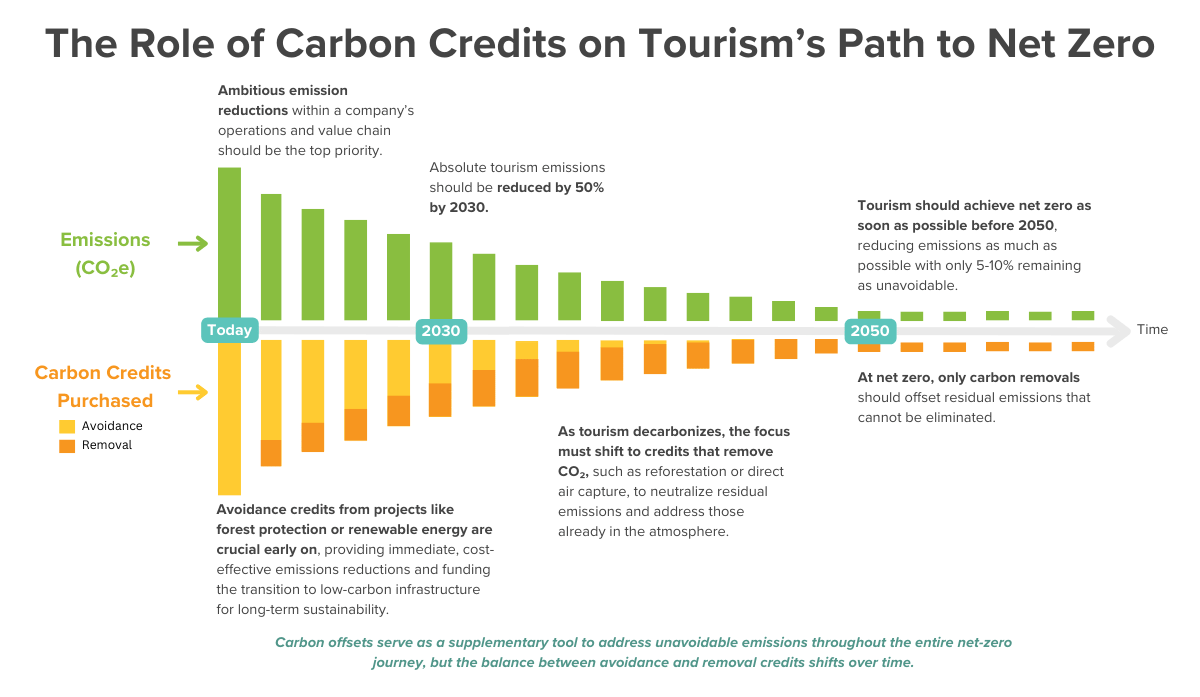
Evaluating Quality Carbon Offsets
Not all carbon offsets are created equal. In recent years, growing scrutiny has highlighted concerns about the quality of some carbon credits, particularly around whether the claimed emissions reductions or removals are real, measurable, and permanent. This section outlines the key principles of quality assurance and how to identify credible carbon offset projects.
Carbon Offset Verification Standards
Independent verification standards uphold the integrity of the voluntary carbon market by establishing clear rules for how projects generate, measure, and verify emissions reductions. To issue legitimate carbon credits, projects must comply with the methodologies defined by the standards and undergo impartial assessment by a third-party auditor. This prevents inflated credit claims and fraud and fosters transparency and trust among buyers, ensuring the credits deliver real environmental benefits.
The main verification standards for carbon offsets are Verra’s Verified Carbon Standard (VCS) and Gold Standard. Other standards include the American Carbon Registry (ACR), Climate Action Reserve (CAR), and Plan Vivo. Newer standards, such as Puro.earth and Carbon Standards International, have also emerged to support innovative carbon removal technologies.
Each standard takes a slightly different approach, focusing on various project types and areas. Here’s how the most widely used carbon offset programs compare.
Verified Carbon Standard (VCS)
- Year Established: 2007
- Size: 2400+ projects registered, 1.3 billion carbon credits issued
- Project Types: Covers a wide range of projects, with renewable energy making up most of the VCS portfolio, followed by waste disposal, industrial energy efficiency, reforestation, waste-to-energy, and avoided deforestation projects. It includes fewer industrial processes, improved forest management, blue carbon, teal carbon, biochar, soil carbon, and agriculture projects.
- Project Locations: Global, with a strong concentration in Asia, Latin America, and Africa. Additional projects are registered in Europe, North America, and Oceania.
- Co-Benefits Certification: Co-benefits may be certified through separate supplementary standards including the Sustainable Development Verified Impact Standard (SD VISta) which verifies contributions toward the UN Sustainable Development Goals (SDGs) and the Climate, Community & Biodiversity (CCB) Standards which verifies nature-based projects (particularly forestry) that deliver measurable climate, community, and biodiversity benefits.
- Notable Characteristics: Largest registry in the voluntary carbon market.
Gold Standard
- Year Established: 2003
- Size: Roughly 2,800 projects registered, 397 million carbon credits issued
- Project Types: Gold Standard’s portfolio is dominated by community energy efficiency and renewable energy projects. It also includes waste-to-energy, afforestation and reforestation, and a smaller share of industrial efficiency projects.
- Project Locations: Global, with a strong concentration of projects in Asia and Africa. Their portfolio also includes projects in Latin America, Europe, Oceania, and North America. Renewable energy efforts focus on least developed countries (LDCs), small island developing states (SIDS), conflict zones, and countries facing barriers to modernizing their energy systems.
- Co-Benefits Certification: Gold Standard verifies all projects against the UN SDGs and requires each to contribute to at least three, including SDG 13 Climate Action. Gold Standard estimates the monetary value of co-benefits, highlighting the broader impact beyond carbon.
- Notable Characteristics: Focuses on household and community-scale projects.
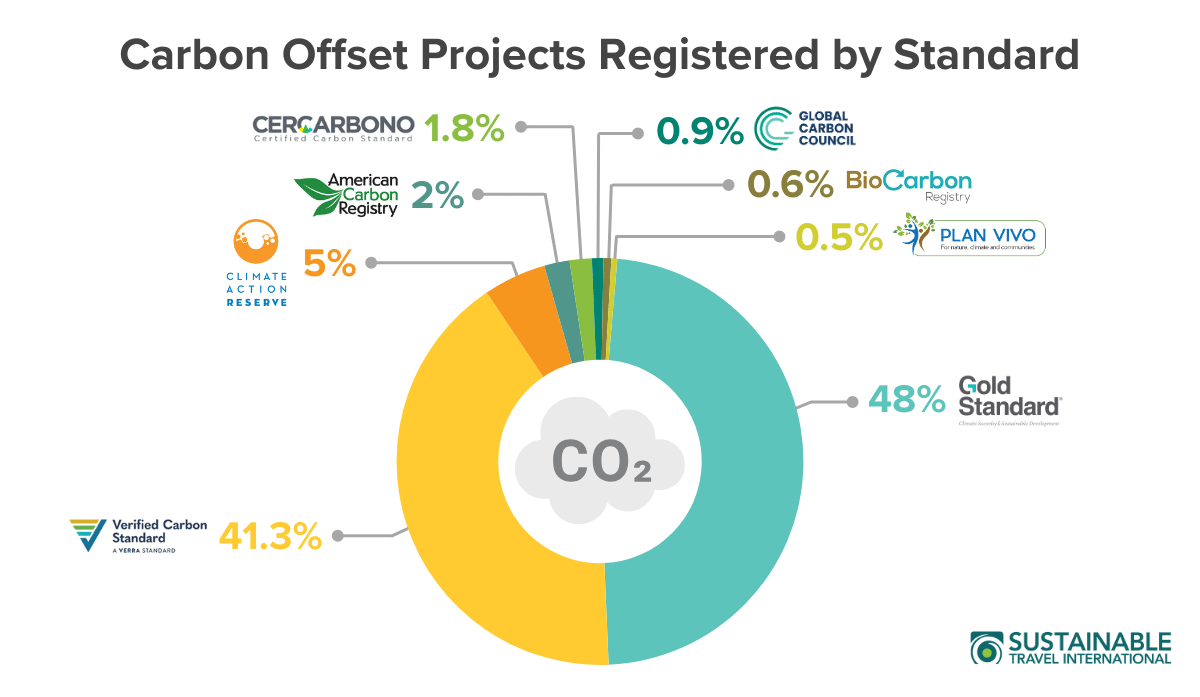
Climate Action Reserve (CAR)
- Year Established: 2001
- Size: Roughly 280 projects registered, 107 million carbon credits issued
- Project Types: CAR’s portfolio is dominated by improved forest management, agriculture, and waste disposal projects. It also includes industrial process offsets, reforestation, and a small number of soil carbon and biochar projects.
- Project Locations: Primarily North America, especially the United States and Mexico.
- Co-Benefits Certification: Projects must self-report SDG contributions and progress each reporting period, but these are not independently verified.
- Notable Characteristics: Validates both compliance and voluntary offset projects.
American Carbon Registry (ACR)
- Year Established: 1996
- Size: Roughly 120 projects registered, 149 million credits issued
- Project Types: ACR’s portfolio is heavily weighted toward industrial processes, improved forest management projects, and industrial energy efficiency projects. It also includes fewer renewable energy, waste disposal, blue carbon, teal carbon, and agriculture projects.
- Project Locations: Heavily concentrated in North America, with the vast majority in the United States. There are fewer projects in Latin America, Asia, and Europe.
- Co-Benefits Certification: Projects must self-report contributions to at least one SDG, including a required focus on SDG 13 (Climate Action); however, they are not required to monitor progress or undergo independent SDG verification.
- Notable Characteristics: Validates both compliance and voluntary offset projects.
Plan Vivo
- Year Established: 1994
- Size: 28 projects registered, 14 million credits issued
- Project Types: Focuses on land use activities including afforestation and reforestation, avoided deforestation, blue carbon, and agriculture.
- Project Locations: Focuses on rural, climate-affected regions where communities depend on natural resources, across Africa, Asia, Latin America, and Oceania.
- Co-Benefits Certification: Plan Vivo verifies all projects against the UN SDGs. By meeting Plan Vivo criteria, projects automatically fulfill requirements that directly support at least six specific SDGs; however, projects typically go beyond these minimum requirements, contributing on average to 11 SDGs.
- Notable Characteristics: The Plan Vivo standard is geared toward smallholder and community-led projects, emphasizing local ownership, participation, and equitable benefit-sharing. At least 60% of revenue goes to communities.
Key Principles of High-Quality Carbon Offsets
These standards don’t just check whether a project reduces emissions—they also look at how reliable and meaningful those reductions are. That includes asking questions like: Would this project have happened without the funding from carbon credits? Could it cause unintended impacts elsewhere? And how long will the carbon stay out of the atmosphere?
These types of questions fall under a few key concepts:
- Additionality ensures that a carbon offset project’s emissions reductions or removals exceed what would have happened under business-as-usual circumstances. In other words, a project is considered additional if it would not have been implemented without the financial incentives provided by carbon credits.
- Overcrediting is when a project claims more emissions reductions than it actually delivers. This can happen if it overestimates what would have happened without the project—the baseline— or relies on unrealistic assumptions. For example, if a forest project claims it prevented deforestation in an area that was never likely to be cleared, then the credits it issued wouldn’t reflect real climate benefits.
- Leakage occurs when an offset project reduces emissions in one area but unintentionally increases them elsewhere. For example, protecting a forest in one area might lead to deforestation shifting to another location, or reducing the supply of a high-emissions commodity like timber, soy, or palm oil could drive increased production elsewhere to meet demand.
- Permanence refers to how long the carbon dioxide removed or avoided stays out of the atmosphere. It’s about making sure a project can reliably store carbon for a set period, usually 25 or 100 years. For instance, if a wildfire burns down a forest, it releases its carbon stores back into the atmosphere, reversing the project’s climate benefit.
High-quality projects reduce these risks by following strict rules set by verification standards, using conservative estimates, planning for unintended impacts, and setting aside buffers in case things don’t go as expected.

Project Co-Benefits
Carbon offset projects often deliver benefits beyond reducing emissions—known as co-benefits—that support communities, ecosystems, and local economies. The type and extent of co-benefits vary widely depending on the project’s design, location, and level of community involvement.
Forest projects, for example, often protect endangered species and uphold land rights and resource access for Indigenous and local communities. In addition, they address poverty, one of the root causes of deforestation, by improving healthcare, education, and livelihoods. Blue and teal carbon projects offer similar co-benefits while safeguarding coastlines from storms and erosion, and supporting fisheries and marine-based livelihoods.
Energy projects often expand access to reliable energy, especially in underserved or rural areas. Cleaner technologies also contribute to better air quality, improving health outcomes, particularly for women.
In contrast, more technical or industrial projects tend to offer fewer or less visible co-benefits. While co-benefits alone don’t define quality, they are one important piece of what makes a carbon offset project high quality. Looking at a project’s co-benefits alongside its carbon performance offers a more complete picture of its overall value.
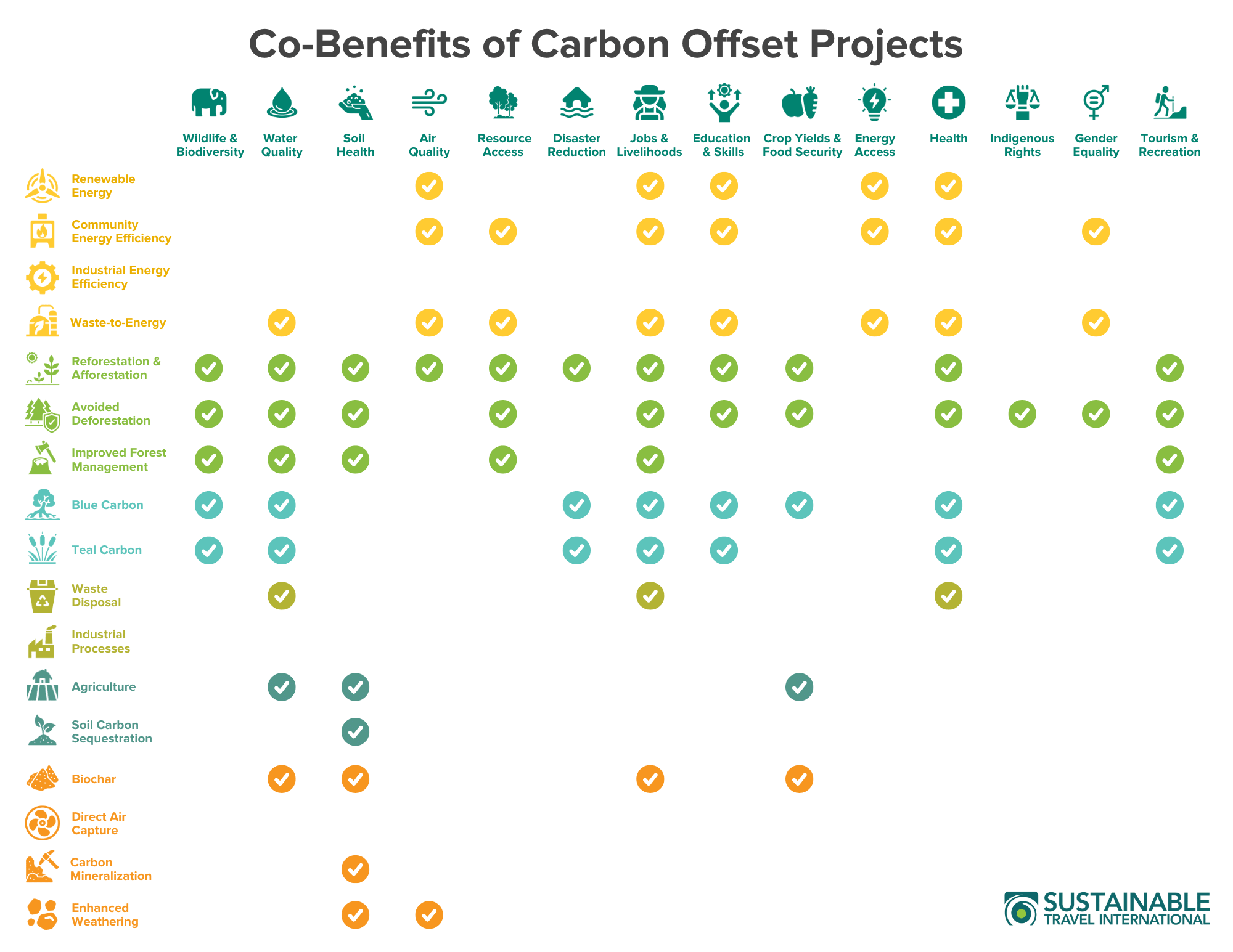
Strengthening Oversight and Accountability in the Carbon Market
As data, technology, and field experience improve, so do the standards that guide carbon offset projects. Offset standards regularly update their methodologies to reflect the latest science and enhance accuracy. For example, Verra’s revised methodology for avoided deforestation addresses concerns that some projects were over-crediting by overestimating deforestation risk. Rather than letting each project set its own baseline, Verra now sets a single, region-wide baseline using trusted, standardized data, making crediting more consistent and credible.
Alongside these updates, new digital tools are transforming how projects are monitored and verified. Digital MRV tools—such as remote sensors, smart meters, satellite imagery, drones, and smartphone applications—can collect real-time project performance data. This allows for greater monitoring accuracy and helps projects respond more quickly to changes on the ground.
New initiatives are adding extra layers of scrutiny to improve quality and build trust in the carbon market. The Integrity Council for the Voluntary Carbon Market (ICVCM) serves as an independent watchdog, evaluating existing carbon standards and methodologies against its Core Carbon Principles (CCPs). It awards the CCP label only to credits that meet high standards for climate impact, environmental and social integrity, and robust carbon accounting. The CCP label is currently being introduced, and assessments are ongoing. Over time, it will help buyers quickly identify credits that meet these high-integrity benchmarks.
Independent rating platforms like Sylvera also support market transparency by assessing the quality of individual carbon projects, scoring them based on key factors like additionality, permanence, and co-benefits. Sustainable Travel International uses Sylvera’s ratings to ensure our portfolio’s credits are credible and impactful.
Purchasing Guide
Carbon Credit Pricing Considerations
Carbon offsetting is generally quite affordable. For instance, using our calculator, offsetting that round-trip flight from New York to London would cost about $24. Making climate solutions like offsets accessible is essential to making them practical and scalable.
The price of a voluntary carbon credit is market-driven and can vary between $1 and $1000 per metric ton. Factors influencing the price include the type of project, standard, location, size, vintage year, market conditions, and overall quality. Projects that are third-party verified and offer substantial co-benefits are typically more expensive. Credits certified for delivering social and environmental co-benefits sell for a 37% price premium compared to those without such certifications.
Smaller-scale projects tend to be more expensive to implement and generate fewer carbon credits. As a result, their credits are often priced higher to cover implementation costs and remain viable. Similarly, emerging carbon removal technologies carry higher price tags because they haven’t achieved economies of scale yet. In contrast, larger, established technologies like wind or solar energy can often produce credits at a lower price.
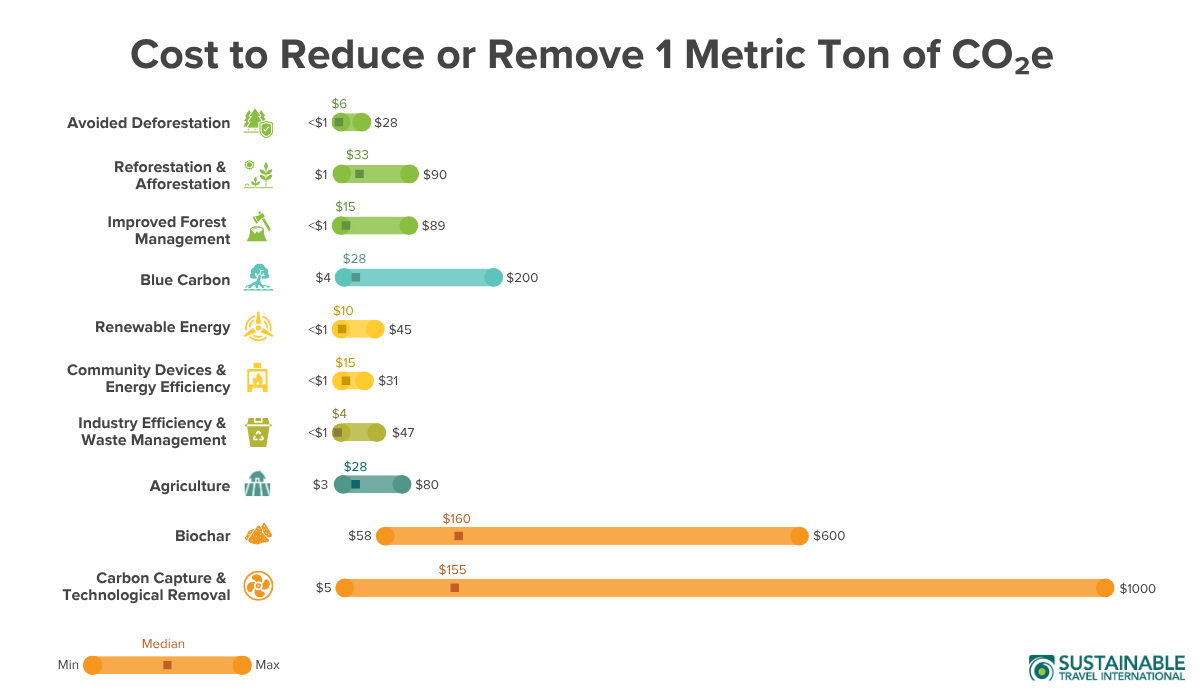
Market dynamics also influence pricing. Like the stock market, the carbon market responds to shifts in supply, demand, and buyer sentiment, and prices can fluctuate daily. For example, a surge of corporate buyers aiming to meet new sustainability requirements could drive up prices. At the same time, negative media coverage can raise skepticism, dampening demand and pushing prices down.
Choosing the Best Carbon Offset Provider
When choosing where to buy carbon offsets, it’s important to look beyond certification and price. The right partner will bring industry-specific expertise, offer transparency into the projects your purchase supports, and conduct extra vetting beyond certification standards to ensure greater credibility and impact.
With deep expertise in travel and tourism, Sustainable Travel International helps businesses and individuals purchase high-quality carbon offsets that reflect what’s most relevant to their goals and the types of emissions they generate. Travelers can use our carbon footprint calculator to purchase verified carbon offsets online. Companies can explore custom offset solutions tailored to their business model, emissions profile, and preferred integration method—whether through customer opt-ins or by building carbon neutrality directly into their experiences.
When you offset with us, your purchase supports a diverse portfolio of high-quality projects, including forestry, energy, blue/teal carbon, and innovative carbon removal solutions. This blended approach keeps offsetting accessible while enabling you to contribute to a broad mix of climate solutions that address emissions from multiple angles. We carefully curate all projects through our internal due diligence process for added quality assurance. We offer transparency in the projects you support—visit our Climate Impact Portfolio to see how your offset contribution is allocated and the environmental and community impact it creates.
To maximize your impact, choose a provider focusing on sustainability action beyond offsets by offering tools, guidance, and strategic support. Sustainable Travel International works with destinations and travel companies to build climate-smart strategies, engage travelers and staff, raise awareness of climate-friendly practices, and support holistic sustainability efforts. Every offset purchase contributes to this broader mission.
Ready to make smarter carbon offset purchases? Explore our Carbon Offset Project Comparison Guide to find the right projects for your goals and ensure your offsets deliver real climate impact.
The Future of Carbon Offsets
Growing pressure for climate action, credibility, and transparency from regulators, investors, and the public is shaping the future of carbon offsets.
As companies pursue ambitious net-zero targets and face stricter climate disclosure requirements, such as Europe’s Corporate Sustainability Reporting Directive (CSRD), many are turning to carbon credits to address emissions that can’t yet be eliminated internally. The Science Based Targets Initiative (SBTi) encourages companies to support high-quality carbon offset projects through its Beyond Value Chain Mitigation guidance, promoting climate action beyond their own operations. In regulated sectors like aviation, the use of offsets is expanding through programs like CORSIA, which will require airlines to offset most international flight emissions above 2019–2020 levels by 2027.
Projections for the voluntary carbon market all point in the same direction: consistent, vigorous growth. According to Global Market Insights, the global voluntary carbon credit market was valued at $1.7 billion in 2024 and is expected to grow rapidly, reaching $15.7 billion by 2034.
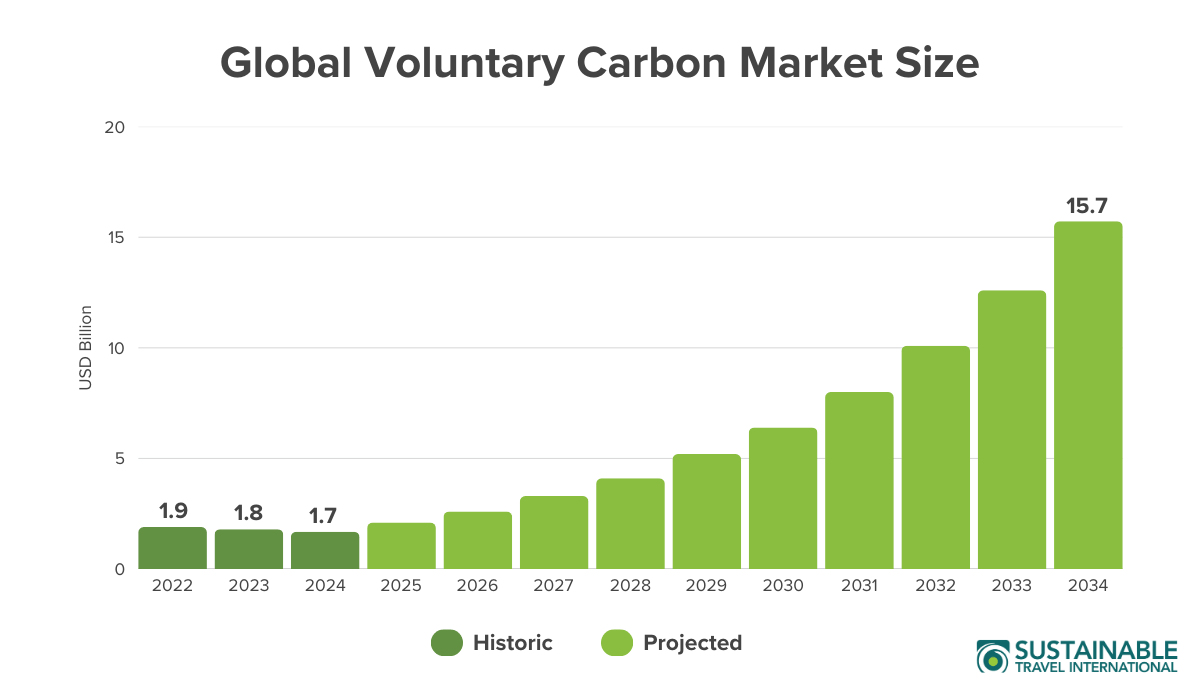
Meanwhile, concerns about greenwashing are driving tighter oversight of the role of carbon offsets and how companies communicate their climate claims. This further increases the importance of transparency and offset quality. Companies must prioritize internal reductions and disclose how carbon credits are used alongside them. The CSRD requires companies to report how and when they use carbon credits, including the types they use. The EU’s Green Claims Directive adds another layer of scrutiny, allowing claims like “carbon neutral” only when they apply to residual emissions and are backed by verifiable evidence and certified carbon removals.
As climate action accelerates, carbon offsets are taking on a more defined and credible role. High-quality carbon credits offer a practical way to support essential climate solutions today. From protecting forests to advancing carbon removal, offsets help reduce emissions now, buying time while long-term decarbonization efforts scale. The future of offsetting isn’t about whether to use them but how to do it right.
Start by calculating your footprint and offsetting your next trip with trusted, high-impact projects.
Calculate and Offset Your Travel Carbon Footprint


 Written By:
Written By: 

